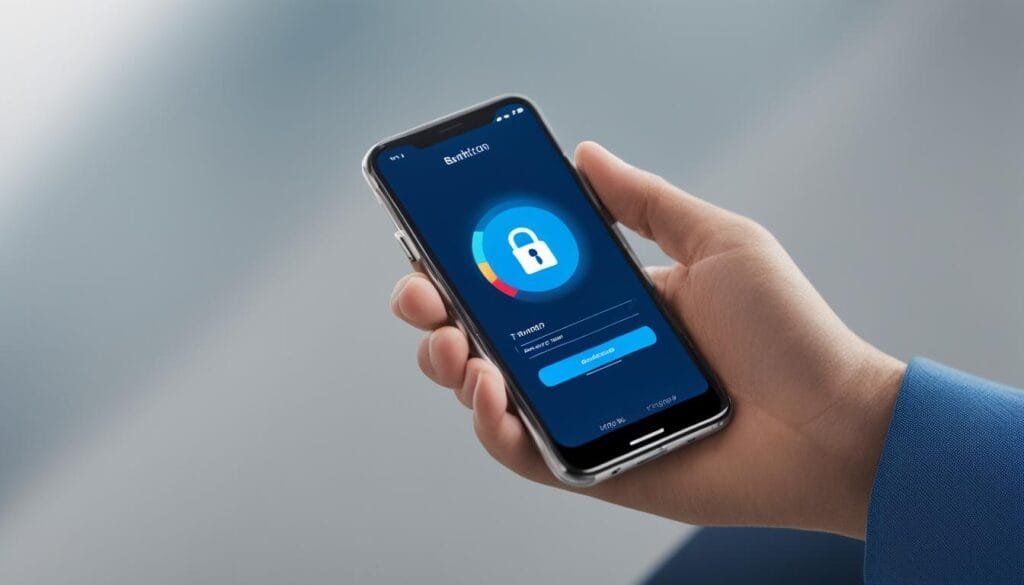Mobile banking has revolutionized the way we manage our finances, providing unparalleled convenience at our fingertips. However, this convenience comes with cybersecurity risks that cannot be ignored. In an era where cyber threats are becoming increasingly sophisticated, financial institutions must prioritize the security of their mobile banking apps and protect their customers from potential attacks.
One crucial aspect of mobile banking security is the use of antivirus software. Antivirus software serves as a shield against a plethora of threats, including ransomware, email phishing, malware proliferation, advanced persistent threats, identity theft, and social engineering. By utilizing robust antivirus solutions, financial institutions can significantly enhance the security of their mobile banking platforms and safeguard their customers’ sensitive financial information.
Key Takeaways:
- Antivirus software plays a vital role in protecting mobile banking apps from various cyber threats.
- Ransomware, email phishing, malware spreading, and identity theft are common threats faced by mobile banking users.
- Implementing best practices such as using a VPN, enabling two-factor authentication, and regularly updating device software can enhance mobile banking security.
- Antivirus solutions like Malwarebytes Endpoint Protection and Malwarebytes Incident Response provide advanced protection and rapid threat detection and removal.
- Securing mobile banking is crucial to protect financial transactions and sensitive information from cyber threats.
Challenges in Mobile Banking Security
Ensuring robust endpoint security and regulatory compliance are among the primary challenges faced by financial institutions in the realm of mobile banking. With sophisticated threats often going undetected on infected endpoints for an average of 98 days, the stakes are high. Non-compliance with regulations like the Gramm-Leach-Bliley Act can lead to hefty fines, while security breaches can result in severe reputational damage that requires extensive time and effort to repair.
Endpoint Security
One of the major challenges in mobile banking security is maintaining effective endpoint security. With the increasing use of mobile devices for conducting financial transactions, endpoints like smartphones and tablets have become lucrative targets for cybercriminals. Malicious actors leverage various tactics, such as phishing attacks and malware proliferation, to exploit vulnerabilities and gain unauthorized access to sensitive data. The financial industry faces the ongoing challenge of ensuring that endpoint devices used for mobile banking are adequately protected against these threats.
Regulatory Compliance
Compliance with regulatory requirements is another critical challenge for financial institutions in the mobile banking landscape. The Gramm-Leach-Bliley Act (GLBA) is one such regulation that mandates the protection of consumer financial information. Failure to comply with GLBA standards can result in substantial penalties and legal consequences. Financial institutions must invest in robust security measures and continuously monitor their systems to ensure compliance with such regulations.
Reputational Damage
Reputational damage is a significant concern for financial institutions operating in the mobile banking space. A security breach can lead to the exposure of sensitive customer data, eroding trust and confidence in the institution. The reputational fallout from such incidents can have far-reaching consequences, including loss of customers, negative media attention, and a decline in market value. Safeguarding customer trust by implementing robust security measures and promptly addressing any incidents is crucial for financial institutions in mobile banking.
| Challenges | Impact |
|---|---|
| Endpoint Security | Potential compromise of sensitive data, unauthorized access, and financial loss |
| Regulatory Compliance | Hefty fines, legal consequences, and damage to the institution’s reputation |
| Reputational Damage | Loss of customer trust, negative media attention, and decline in market value |
Addressing these challenges requires a comprehensive approach that encompasses effective endpoint security measures, strict compliance with regulatory mandates, and proactive reputation management. Financial institutions must continuously adapt their security strategies to keep pace with evolving threats and invest in robust cybersecurity solutions that provide real-time protection against mobile banking risks.
Common Threats in Mobile Banking
Mobile banking has revolutionized the way we manage our finances, offering convenience and accessibility at our fingertips. However, it also exposes users to various cybersecurity threats. It is crucial for mobile banking users to be aware of these threats and take appropriate measures to protect themselves.
Ransomware: One of the most significant threats to mobile banking is ransomware. This malicious software encrypts users’ data and demands a ransom for its release. It can lock users out of their accounts or even steal sensitive information, causing significant financial and personal losses.
Email phishing: Another common threat is email phishing, where scammers impersonate legitimate institutions to trick users into providing their personal and financial information. These phishing emails often appear genuine and can be challenging to identify, making users susceptible to identity theft and financial fraud.
Malware spreading: Mobile banking apps are also vulnerable to malware spreading, which can infect a user’s device and compromise their banking credentials. Malware can be spread through malicious links, fake apps, or even compromised websites, putting users’ financial data and transactions at risk.
“Mobile banking apps are vulnerable to various threats, including ransomware, email phishing, malware spreading, advanced persistent threats, identity theft, and social engineering.”
Advanced persistent threats (APTs): APTs are highly sophisticated cyber attacks that target specific individuals or organizations. These threats are often perpetrated by skilled hackers who gain unauthorized access to users’ devices or networks, allowing them to monitor and steal sensitive banking information over an extended period.
Identity theft: Identity theft is a prevalent threat in the digital age. Cybercriminals can use stolen personal information to open fraudulent accounts, make unauthorized transactions, and wreak havoc on users’ financial lives. Mobile banking users must be vigilant and take precautions to protect their identities.
Social engineering: Lastly, social engineering involves manipulating users into divulging their personal information or performing actions that compromise their security. Fraudsters may use social engineering techniques, such as impersonating bank representatives or creating false emergencies, to trick users into revealing sensitive information or making unauthorized transactions.
| Threat | Description |
|---|---|
| Ransomware | Malicious software that encrypts data and demands a ransom for its release. |
| Email Phishing | Fraudulent emails that trick users into revealing personal and financial information. |
| Malware Spreading | Spread of malware through malicious links, fake apps, or compromised websites. |
| Advanced Persistent Threats (APTs) | Highly sophisticated cyber attacks targeting specific individuals or organizations. |
| Identity Theft | Unauthorized use of personal information to open fraudulent accounts or make unauthorized transactions. |
| Social Engineering | Manipulating users into revealing sensitive information or performing actions that compromise security. |
How Antivirus Software Helps Protect Mobile Banking
Antivirus software plays a crucial role in protecting mobile banking apps from various threats. Solutions like Malwarebytes Endpoint Protection and Malwarebytes Incident Response offer advanced protection and multiple layers of defense to keep financial transactions and sensitive information secure.
These antivirus software utilize cloud-based platforms and advanced technologies to detect and block threats such as ransomware, malware spreading, and phishing attacks. By leveraging real-time threat intelligence, these solutions can identify and neutralize malicious activities, ensuring the integrity of mobile banking apps.
One of the key benefits of antivirus software is their ability to provide rapid detection and removal of advanced threats from infected endpoints. This helps minimize the dwell-time of malware and prevents further damage to mobile banking users’ devices and data.
“Antivirus software like Malwarebytes Endpoint Protection and Malwarebytes Incident Response offers advanced protection for mobile banking.”
Furthermore, these antivirus solutions also offer forensic capabilities, allowing financial institutions to investigate security incidents and address any security gaps. This proactive approach helps prevent future attacks and strengthens the overall security posture of mobile banking.
Key Features of Antivirus Software for Mobile Banking Protection
When choosing antivirus software for mobile banking protection, it is essential to consider the following key features:
- Real-time threat detection and prevention
- Cloud-based platforms for up-to-date protection
- Rapid detection and removal of advanced threats
- Forensic capabilities for incident investigation
- Advanced technologies to block ransomware, malware, and phishing attacks
By selecting antivirus software that encompasses these features, financial institutions can ensure the highest level of security for their mobile banking apps, protecting both themselves and their customers from potential threats.

| Benefits of Antivirus Software for Mobile Banking Protection | Malwarebytes Endpoint Protection | Malwarebytes Incident Response |
|---|---|---|
| Real-time threat detection and prevention | ✓ | ✓ |
| Cloud-based platforms for up-to-date protection | ✓ | ✓ |
| Rapid detection and removal of advanced threats | ✓ | ✓ |
| Forensic capabilities for incident investigation | ✓ | ✓ |
| Advanced technologies to block ransomware, malware, and phishing attacks | ✓ | ✓ |
Table: A comparison of the benefits provided by Malwarebytes Endpoint Protection and Malwarebytes Incident Response for mobile banking protection.
Tips for Secure Mobile Banking
Ensuring the security of your mobile banking activities is crucial to protect your financial information from cyber threats. By following these tips, you can enhance the security of your mobile banking experience:
1. Use a VPN for Secure Internet Connections
When accessing mobile banking apps, it is important to use a Virtual Private Network (VPN) to establish a secure and encrypted connection. A VPN creates a private network from a public internet connection, ensuring that your data remains protected and hidden from potential hackers.
2. Set Up Two-Factor Authentication
Enable two-factor authentication (2FA) for your mobile banking apps whenever possible. 2FA adds an extra layer of security by requiring you to provide a secondary form of verification, such as a fingerprint scan or a one-time password sent to your registered mobile number, in addition to your login credentials.
3. Create Complex Passwords
Ensure that your mobile banking account is protected with a strong and unique password. Use a combination of uppercase and lowercase letters, numbers, and special characters to create a complex password that is difficult for hackers to guess. Avoid using easily guessable information, such as your name or birthdate, as part of your password.
4. Regularly Update Device Software
Keep your mobile device’s operating system and apps up to date with the latest software updates. These updates often include security patches that address vulnerabilities and protect your device from potential security breaches. Enable automatic updates whenever possible to ensure that you are always using the most secure version of your mobile banking apps.
5. Activate Security Alerts
Enable security alerts and notifications provided by your mobile banking apps. These alerts can notify you of any suspicious activities or potential security threats, allowing you to take immediate action to safeguard your accounts. Stay vigilant and report any suspicious activities to your bank’s customer support.
By following these tips, you can ensure a safer mobile banking experience and minimize the risks associated with cyber threats.

Conclusion
Securing mobile banking is crucial to protect financial transactions and sensitive information from cyber threats. With the increasing risks in the digital landscape, having antivirus software is a critical component of mobile security. By utilizing reliable cybersecurity software, users can safeguard their mobile banking apps against malware, phishing attacks, and other security risks.
Implementing best practices and robust security measures is essential for a safer banking experience. Antivirus software plays a significant role in shielding mobile banking apps from potential threats, providing users with peace of mind. Regular software updates, strong passwords, and two-factor authentication are additional measures that enhance mobile banking security, ensuring protection against cyberattacks, data breaches, and unauthorized access to user accounts.
As technology advances, so do the tactics of cybercriminals. It is crucial for individuals and financial institutions to stay vigilant and proactive in their approach to mobile banking security. By prioritizing the implementation of antivirus software and following recommended security practices, users can minimize the risks associated with mobile banking and enjoy a secure and reliable banking experience.
FAQ
What are the common threats in mobile banking?
Common threats in mobile banking include ransomware, email phishing, malware spreading, advanced persistent threats, identity theft, and social engineering.
How can antivirus software help protect mobile banking?
Antivirus software such as Malwarebytes Endpoint Protection and Malwarebytes Incident Response offers advanced protection for mobile banking apps. These solutions utilize cloud-based platforms and multiple layered protection technologies to detect and block advanced threats, including ransomware. They also provide rapid detection and removal of advanced threats from infected endpoints, along with forensic capabilities to address security gaps and reduce malware dwell-time.
What tips can enhance mobile banking security?
To enhance mobile banking security, it is recommended to use a VPN for secure internet connections, set up two-factor authentication, create complex passwords, regularly update device software, and activate security alerts.
Can Using Antivirus Software Improve My Credit Score?
Using antivirus software can protect your devices from cyber threats, but it has no direct impact on credit scores. However, mobile banking’s impact on credit scores is worth considering. Timely payments through mobile banking apps can positively affect your credit history, as it demonstrates responsible financial behavior.


Pingback: Rule the Rules: Navigating Compliance and Regulations in Mobile Banking – Straight Fire Money